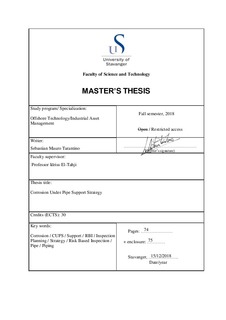| dc.contributor.advisor | El-Thalji, Idriss | |
| dc.contributor.author | Tarantino, Sebastian Mauro | |
| dc.date.accessioned | 2019-02-20T13:57:36Z | |
| dc.date.available | 2019-02-20T13:57:36Z | |
| dc.date.issued | 2018-12-14 | |
| dc.identifier.uri | http://hdl.handle.net/11250/2586579 | |
| dc.description | Master's thesis in Offshore technology | nb_NO |
| dc.description.abstract | Due the increment of the incidents related with corrosion under pipe supports (CUPS) at Borealis Plastomer Plant at Chemelot Site located in Geleen, Netherlands, it was decided by the management to face this problem and develop a CUPS Strategy to handle the more than 4000 piping supports located at the plant, and extend the implementation to other Borealis plants.
For this strategy it was decided to develop a Risk Based Inspection (RBI) methodology to handle such amount of supports and prioritize them. The RBI approach provides a likelihood and consequence assessment that are developed and can be used separately, and when combined a risk value is obtained, a very powerful prioritization tool. Likelihood and consequence can be calculated in many different ways, depending the degree of complexity that wants to be used, more information is going to be needed and more time must be spent in the development of the tool and its implementation. Also, flexibility is being reduced with the increase in complexity. Usually when less information and general characteristics are used it is called a qualitative approach, and when more information is needed and complexity increased, it is called a semi-quantitative up to reach a quantitative approach.
For this strategy a full development of a qualitative probability was performed. The consequence calculation is described and it is intended to be used the system already implemented at Borealis. However, an easy qualitative consequence calculation was developed for the cases that a full RBI approach is not yet implemented at the site. The intention of this calculation is to get an easy and fast calculation method for the consequence and have a first prioritization to start with the needed jobs to reduce the risk at the plant. Indeed, it is recommended to implement a full RBI methodology and use the consequence calculated in that implementation for the CUPS strategy.
The Risk Based Inspection (RBI) is a very good method to prioritize a process or a part of a process equipment based in the likelihood and consequence of failure, given the risk. After evaluation of the piping supports and risk calculation a prioritization by risk is obtained and it can be decided how to manage them, plan the necessary actions for inspection, maintenance and replacement if needed in order to operate the plant safely. | nb_NO |
| dc.language.iso | eng | nb_NO |
| dc.publisher | University of Stavanger, Norway | nb_NO |
| dc.relation.ispartofseries | Masteroppgave/UIS-TN-IMBM/2018; | |
| dc.rights | Navngivelse 4.0 Internasjonal | * |
| dc.rights.uri | http://creativecommons.org/licenses/by/4.0/deed.no | * |
| dc.subject | CUPS | nb_NO |
| dc.subject | RBI | nb_NO |
| dc.subject | offshore teknologi | nb_NO |
| dc.subject | undervannsteknologi | nb_NO |
| dc.subject | corrosion | nb_NO |
| dc.subject | support | nb_NO |
| dc.subject | inspection planning | nb_NO |
| dc.subject | strategi | nb_NO |
| dc.subject | risk based inspection | nb_NO |
| dc.subject | pipe | nb_NO |
| dc.subject | piping | nb_NO |
| dc.title | Corrosion Under Pipe Support Strategy | nb_NO |
| dc.type | Master thesis | nb_NO |
| dc.subject.nsi | VDP::Teknologi: 500::Marin teknologi: 580::Offshoreteknologi: 581 | nb_NO |

